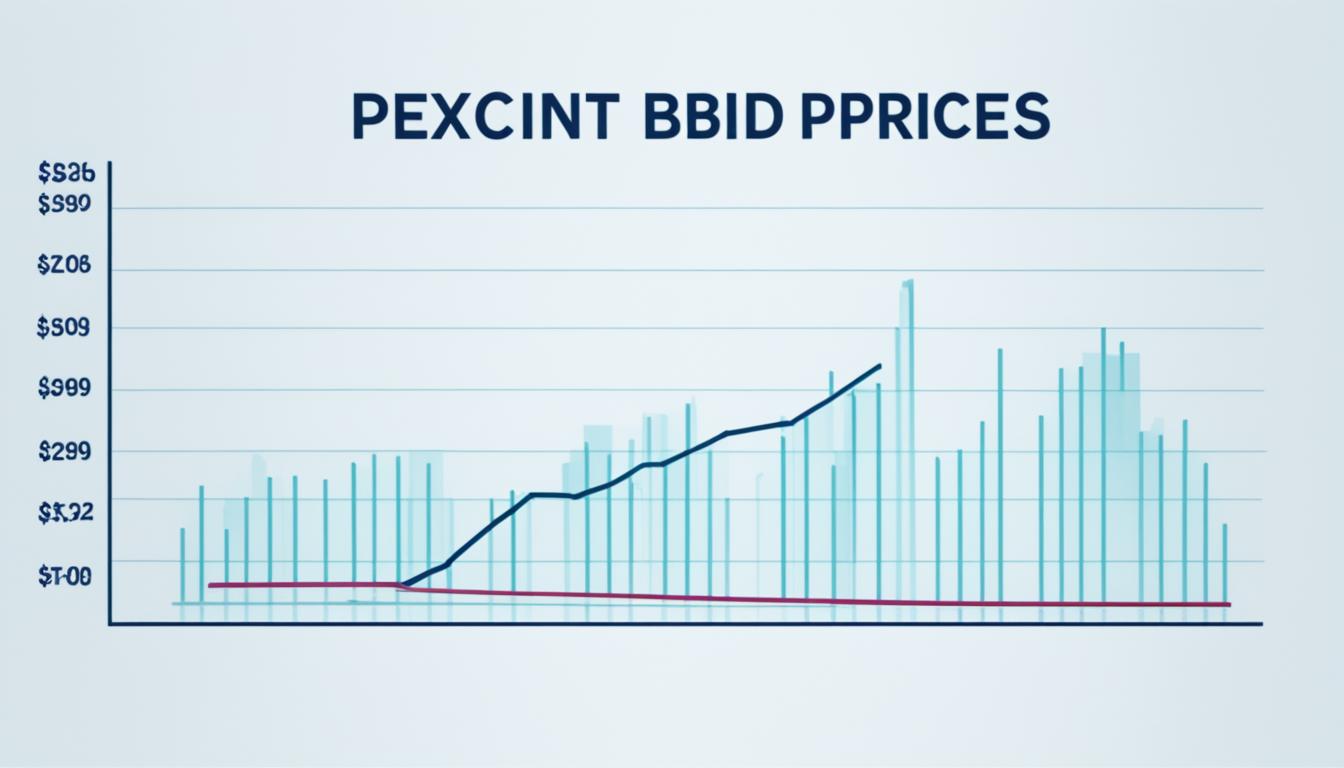What is a Spread in Forex?
Did you know the global forex market sees over $6.6 trillion traded daily? As a forex trader, understanding spreads is key. This concept is crucial to manage your costs and boost your profits.
In forex, a spread is the gap between a currency pair’s bid and ask prices. It’s a trading cost. Brokers use it to earn money. A smaller spread means lower trading costs, while a bigger spread means you’ll pay more. Knowing how to evaluate and compare spreads lets you make smarter choices. This can up your success chances in forex trading’s fast-paced scene.
Key Takeaways
- Spreads are the difference between the bid and ask prices in forex trading
- Understanding spreads is essential for managing trading costs and making informed decisions
- Tighter spreads mean lower trading costs, while wider spreads indicate higher costs
- Comparing spreads across brokers can help you find the most cost-effective trading opportunities
- Spreads can vary depending on market conditions, currency pair popularity, and broker policies
Understanding the Basics of Forex Spreads
As you start trading forex, you’ll quickly learn about forex spreads. These are key to making smart trading choices. You need to know about spreads to keep your trading costs low.
Defining Forex Spreads
A forex spread shows the difference between what you can buy and sell a currency for. The ‘bid’ price is what you sell a currency pair for. The ‘ask’ price is what you buy it for. This spread is the cost of doing a trade.
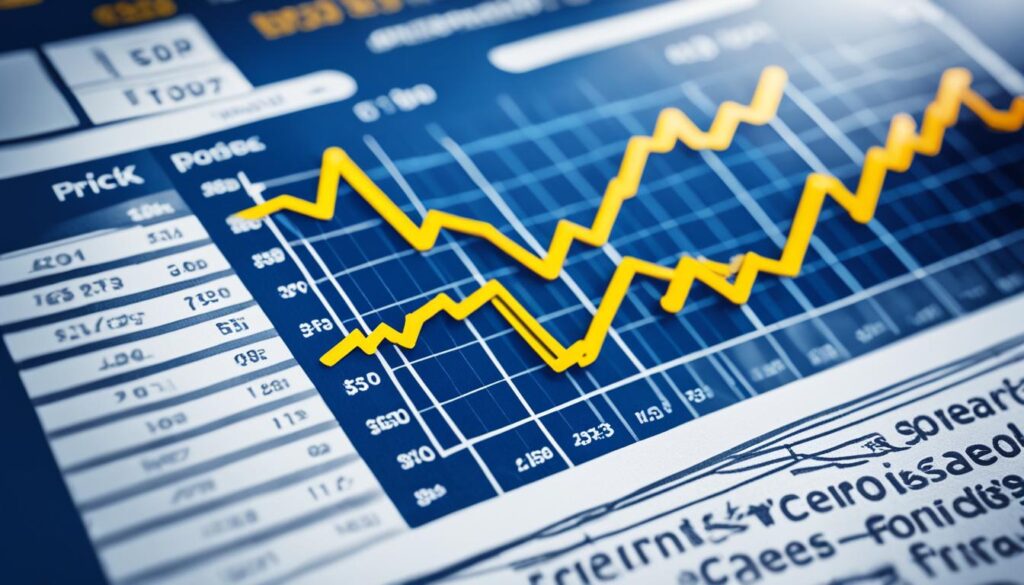
Spreads are often talked about in terms of ‘pips,’ the smallest price movement. For instance, if EUR/USD is being sold for 1.1200 but bought for 1.1202, the spread is 2 pips.
The Role of Spreads in Forex Trading
Spreads really matter in trading. They affect your costs and how much money you can make. Trading is more expensive with bigger spreads. This makes it harder to be profitable.
Spreads also tell you how easy it is to trade a currency. Major pairs like EUR/USD or USD/JPY have small spreads. This is because a lot of trades happen. But, if a pair isn’t traded often, the spread can be wider.
Knowing about spreads helps you figure out potential wins and losses. It’s also important for seeing which broker offers the best deal.
Here’s what you should keep in mind about forex spreads:
- Spreads show the cost of trading and are in pips.
- Low spreads mean it costs less to trade.
- High spreads mean trading is more expensive.
- Spreads change depending on the pair and the market.
Understanding spreads can help you trade better. It means making smarter choices and lowering your risk. This could make you a stronger trader.
Bid-Ask Spread in Forex
When you get into forex trading, knowing the bid-ask spread is key. It affects your costs and profits. Understanding how the bid and ask prices work together is important.
Bid Price and Ask Price Explained
The bid price is what a buyer offers to pay. The ask price is the seller’s selling price. The difference between these is the spread. It’s vital for trading smartly in forex.
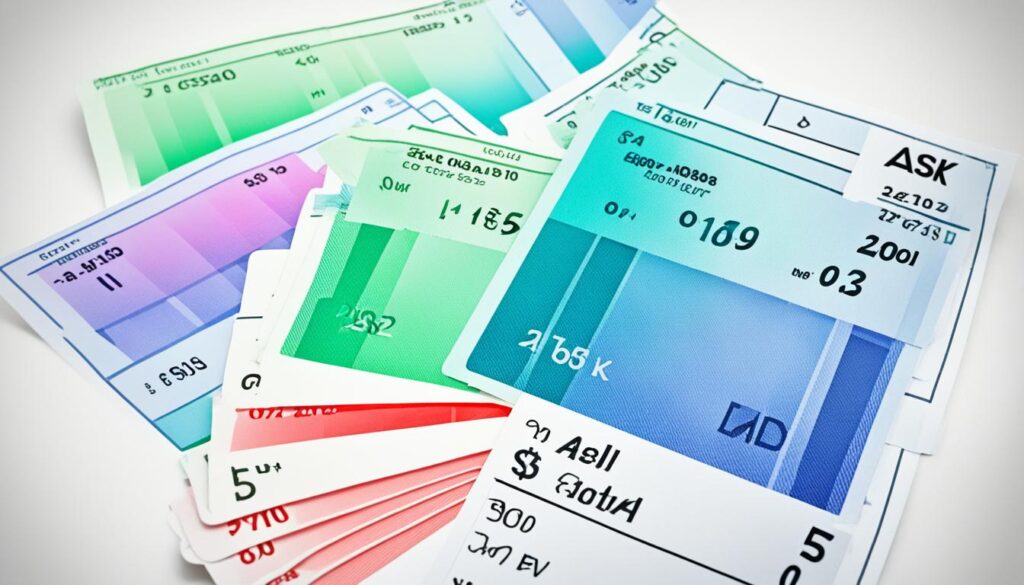
For example, let’s say you want to buy EUR/USD. If the bid price is 1.1200 and the ask price is 1.1202, the spread is 2 pips. You pay the ask price to buy and sell at the bid price.
How Bid-Ask Spreads Affect Forex Traders
The spread affects what you pay to trade and your profits. A big spread means more costs. A small one means lower costs. Always keep spread costs in mind.
| Currency Pair | Bid Price | Ask Price | Bid-Ask Spread |
|---|---|---|---|
| EUR/USD | 1.1200 | 1.1202 | 2 pips |
| GBP/USD | 1.3500 | 1.3503 | 3 pips |
| USD/JPY | 110.00 | 110.05 | 5 pips |
Currency pairs show different spreads, as seen in the table. The spread affects how much the price must move for you to profit. Consider this in your trading decisions.
Knowing the forex spread helps you trade wisely. Watch the spreads for your chosen currency pairs. Include them in your risk and profit planning.
Calculating Forex Spreads
To trade in the forex market wisely, you must know how to calculate forex spreads. The bid and ask prices difference, shown in pips, is what we mean by the forex spread. Learning this helps you figure out the costs and risks of trading.
Think about trading the EUR/USD. If the bid is 1.1200 and the ask is 1.1204, the spread is found by subtracting:
1.1204 – 1.1200 = 0.0004
The forex pip spread in this example is 0.0004, or 4 pips. This means a trade from asking to bidding would lose you 4 pips.
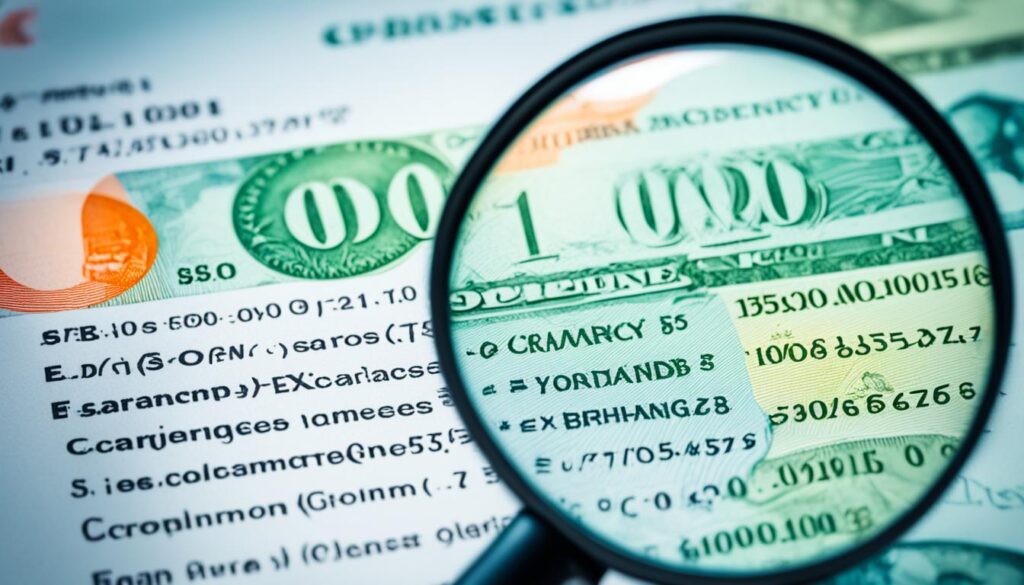
Remember, a pip’s value changes based on the currency and trade size. Most pairs use the fourth decimal for a pip (0.0001). But, with pairs involving the JPY, a pip is the second decimal (0.01).
Consider this table to see how spreads differ:
| Currency Pair | Bid Price | Ask Price | Spread (in Pips) |
|---|---|---|---|
| EUR/USD | 1.1200 | 1.1204 | 4 |
| GBP/USD | 1.3500 | 1.3505 | 5 |
| USD/JPY | 110.00 | 110.05 | 5 |
Different currency pairs have different spreads. Even small spread changes greatly affect your costs. By knowing how to calculate and compare forex spreads, you can choose the best pairs to trade and the best brokers.
In the end, knowing forex spreads and how to calculate them is key for trading success. Watching the bid-ask spreads and using them in your strategies can lower costs and raise profits.
Forex Pip Spread
In the forex market, knowing about pip spreads is key. A pip is short for “percentage in point.” It’s the smallest change in a currency pair’s rate, usually the fourth decimal. But, for the Japanese yen, it’s the second decimal.
The spread, the difference between buying and selling prices, shows a trade’s cost. The forex pip spread is the cost of a trade for you. It’s vital to understand how this affects your trades and gains.
What is a Pip in Forex?
A pip is the smallest change in a currency’s value in forex. For many pairs, a pip is 0.0001, or 1/10000th of the quoted currency. For example, if the EUR/USD moves from 1.1050 to 1.1051, that’s a one-pip move.
But, for Japanese yen pairs like USD/JPY, a pip is 0.01, or 1/100th. This is because yen quotes use two decimal places.
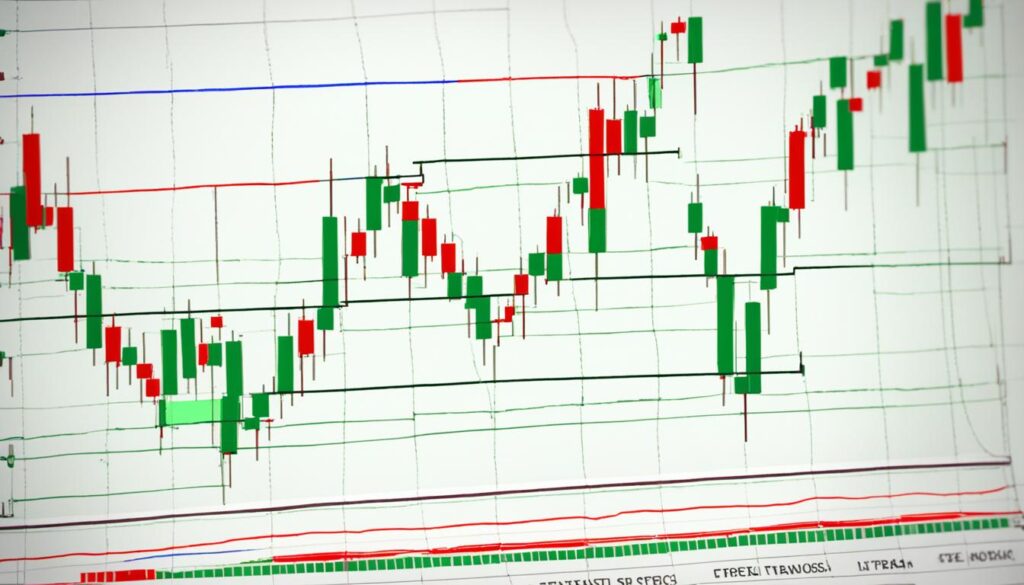
How Pip Spreads Impact Trading Decisions
Knowing about spreads is vital for managing costs and profits. A larger spread means the price must move more in your favor to profit. Tighter spreads are better because costs are lower and profits higher.
Consider spread costs when making trades. Large spreads can reduce profits, especially with quick trades or small price changes. Choose pairs with tight spreads to cut costs.
Forex spreads change based on market conditions. High volatility or low liquidity can make spreads widen, which increases costs. You should keep an eye on this and adjust your strategy as needed.
Pip spreads have a big impact on your forex trading. Know how they work to reduce risk and improve gains.
To sum up, understanding the forex pip spread is crucial for all traders. Keep informed about spreads and their effects on costs to make better trading choices and boost performance.
Types of Forex Spreads
In forex trading, you’ll find two main spread types: fixed spreads and variable spreads. It’s key to know the difference. This helps you make smart choices for your trading style and the market’s state.
Fixed Spreads vs. Variable Spreads
Fixed spreads stay the same even if the market goes crazy. They bring stability to your trading costs. But, variable spreads change with the market, getting wider in turbulent times. They get tighter when the market is calm. This means they can be better for traders looking to save money.
Advantages and Disadvantages of Each Type
Both fixed and variable spreads have their pros and cons. Think carefully about your options when it comes to choosing between them:
| Spread Type | Advantages | Disadvantages |
|---|---|---|
| Fixed Spreads |
|
|
| Variable Spreads |
|
|
When picking between fixed and variable spreads, think about your trading style and how much risk you can handle. If you like knowing your costs ahead of time, go for fixed spreads. But if you want to save money and know when to jump on good prices, variable spreads are a good choice.
Understanding these differences helps you choose the best spread type for your trading style and the market’s situation.
What is a Spread in Forex?
Understanding spreads is key in forex trading. They help us make smart choices and manage costs. A spread in forex is the gap between the buying price and the selling price for a currency pair. It shows the cost to start a trade, in terms of pips.
A Comprehensive Definition
A forex spread is the fee a broker takes for helping with your trade. When you buy, you pay a bit more than the real price. If you sell, you get a bit less. This difference is the spread, and it changes with the currency pair and the market.
For the EUR/USD, if the bid is at 1.1200 and the ask at 1.1202, the spread is 2 pips. So, starting, you’re a bit behind. You need good price moves to turn a profit.
Factors Influencing Forex Spreads
Many things can make forex spreads bigger or smaller. Knowing what these are helps make better trading choices and can save money. Main factors include:
- Market Volatility: High market changes mean more risk for brokers. So, they might widen spreads. This helps them manage better because prices may move in unpredictable ways.
- Liquidity: Popular pairs like EUR/USD have lower spreads due to many trades. But, in pairs with less action, spreads are usually bigger.
- Currency Pair Popularity: How famous a pair is can change its spread. Major pairs usually have tighter spreads than minor ones.
- Market Hours: Spreads change by the day and during market open times. More people trading can mean tighter spreads. But, expect spreads to be wider when trading is less active.
Knowing what spreads are and what influences them is essential. It guides when to trade and on which pairs to focus. Remember, looking only at spreads isn’t enough. You should also check a broker’s overall service, like trade quality and tools.
Tight vs. Wide Forex Spreads
When talking about forex spread types, you often hear of “tight” and “wide” spreads. It’s important to know about forex spreads for smart trading.
A tight forex spread means the difference between buying and selling prices is small. Traders like this because it means lower costs. Major pairs, like EUR/USD or USD/JPY, usually have tight spreads. This is because they are highly traded.
Wide forex spreads show a big gap between prices. This happens with less traded pairs or in a volatile market. Trading with wide spreads can cost more. You need the price to move a lot to make money.
While tight spreads are great, remember to look at other things too. Market conditions, volatility, and your trading style also matter.
Let’s look at the good and bad of tight and wide spreads:
- Tight spreads:
- Lower costs to trade
- Great for those who trade a lot
- Good for quick, in-and-out trading
- Wide spreads:
- Cost more to trade
- Not as good for lots of trading
- Better for holding onto trades for a while
Here’s what you can expect from different currency pairs:
| Tight Spread Pairs | Wide Spread Pairs |
|---|---|
| EUR/USD | EUR/TRY |
| USD/JPY | USD/ZAR |
| GBP/USD | GBP/NZD |
By knowing about forex spreads, you make better choices. This is true when picking currency pairs and planning your trading.
Spread Costs in Forex Trading
Understanding spread costs is key in forex trading. Spreads are the difference between a currency pair’s bid and ask price. They add to your trading costs. To boost your trading success and returns, learn to lower these costs.
How Spreads Affect Your Trading Costs
Every trade you make includes spread costs. If the spread is wide, buying and selling positions costs more. For big or frequent trades, these costs quickly add up. Let’s use an example to show how spreads affect your costs:
| Currency Pair | Spread (Pips) | Cost per Standard Lot |
|---|---|---|
| EUR/USD | 1.5 | $15 |
| GBP/USD | 2.0 | $20 |
| USD/JPY | 1.8 | $18 |
Even small changes in spreads significantly affect your trading costs. Over time, these costs reduce your profits. Knowing how to lessen the impact of spreads is crucial in forex trading. It can make or break your success.
Minimizing Spread Costs
There are ways to decrease spread costs in forex. Try these effective methods:
- Trade when the market is busiest. Spreads are usually tighter then, which can lower your costs.
- Choose pairs known for tight spreads, like EUR/USD or USD/JPY. This reduces spread costs in your trades.
- Use limit orders to enter trades at better prices. This can help you avoid higher effective spreads.
- Compare spreads from different brokers. Opt for those with the best spread offers for your chosen currency pairs.
By applying these strategies and keeping an eye on spread costs, you can enhance your trading decisions. Even slight improvements in managing spreads can have a big positive effect on your trading performance over time.
Forex Spread Comparison Across Brokers
When you trade forex, comparing spreads is key. Spreads are the difference between buying and selling prices. They directly affect your costs and profits. Picking a broker with low spreads is wise. This helps cut your costs and boost earnings. Doing a careful spread comparison lets you trade smarter.
Importance of Comparing Spreads
Why is it important to compare spreads? It helps find the cheapest chances to trade. This lowers costs and raises profits. You also get the best deals for your trades. Plus, you can access better prices with narrower spreads.
By looking at different brokers’ spreads, you learn about their trading setup. This lets you pick the one that matches your goals and strategies.
How to Compare Forex Spreads Effectively
For a smart spread comparison, keep these steps in mind:
- Compare average spreads for the currencies you want to trade. This shows who’s most competitive.
- Look at minimum and maximum spreads to know the full cost range.
- Check how steady a broker keeps their spreads. This impacts your trading’s reliability.
- Analyze spreads during market swings. This helps you trade well in all conditions.
Remember, low spreads are important but not the only thing. Choose brokers who offer reliable platforms, good support, and have a solid reputation too.
Here’s a sample table to compare brokers:
| Broker | EUR/USD Average Spread | GBP/USD Average Spread | USD/JPY Average Spread |
|---|---|---|---|
| Broker A | 0.8 pips | 1.2 pips | 0.9 pips |
| Broker B | 1.2 pips | 1.5 pips | 1.1 pips |
| Broker C | 0.5 pips | 0.8 pips | 0.7 pips |
Comparing forex spreads well can improve how you trade. Understanding your trading costs is crucial. It can boost your profit and trading satisfaction.
Managing Risks Associated with Forex Spreads
Understanding the risks of trading forex is key, especially with spreads. Spreads can raise your trading costs and affect your profits. Larger spreads mean you pay more for each trade, potentially lowering your profits.
Spreads might also get bigger during market turmoil or when trading volumes are low. This can lead to slippage, affecting your trades.
It’s smart to put stop-loss orders in place to protect against big losses. This means setting a price point where you automatically sell. Doing this can help you avoid major losses from spread changes.
Keep an eye on spread changes, especially near big economic events or news. These times can see spreads fluctuate a lot, potentially impacting your trades.
Integrating spread management into your trading strategy is another good idea. This means considering the impact of spread costs when you plan your trades and set your profit goals. With this approach, you make smarter trading choices by understanding how different spread types affect you.
Remember, knowing about forex spreads is critical. It helps you manage risk better and improve your trading in the forex market.
